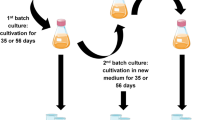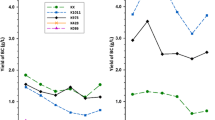Abstract
To improve the yield of cellulose production in bacteria, we investigated the stimulatory effects of six different alcohols during fermentation of Acetobacter xylinum 186. Our study showed that after static fermentation at 30°C for 6 days, bacterial culture with 1.0% (v/v) of methanol added in the medium produced the highest bacterial cellulose (BC) yield at 103.5 mg/100 ml, which was 21.8% higher than the control group. Addition of 0.5% of ethylene glycol in the culture yielded 105.5 mg/100 ml BC, 24.1% higher than the control group. Adding 0.5% of n-propanol yielded 96.4 mg/100 ml BC, 13.4% higher; 3.0% of glycerol yielded 108.3 mg/100 ml BC, 27.4% higher; 0.5% of n-butanol yielded 132.6 mg/100 ml BC, 56.0% higher; and 4.0% of mannitol in the culture yielded 125.2 mg/100 ml BC, 47.3% higher, respectively. The rate of bacterial cellulose production increased with the growth rate of the bacteria. The stimulatory effects of these alcohols that we observed were significant in the later stage of fermentation, which was considered to be important for the biosynthesis of bacterial cellulose.




Similar content being viewed by others
References
Bäckdahl H, Helenius G, Bodin A, Nannmark U, Johansson BR, Risberg B, Gatenholm P (2006) Mechanical properties of bacterial cellulose and interactions with smooth muscle cells. Biomaterials 27:2141–2149
Bae S, Sugano Y, Shoda M (2004) Improvement of bacterial cellulose production by addition of agar in a jar fermentor. J Biosci Bioeng 97:33–38
Czaja W, Krystynowicz A, Bielecki S, Brown RM Jr (2006) Microbial cellulose—the natural power to heal wounds. Biomaterials 27:145–151
Embuscado ME, Marks JS, BeMiller JN (1994) Bacterial cellulose. I. Factors affecting the production of cellulose by Acetobacter xylinum. Food Hydrocolloid 8:407–418
Hestrin S, Schramm M (1954) Synthesis of cellulose by Acetobacter xylinum. II. Preparation of freeze-dried cells capable of polymerizing glucose to cellulose. Biochem J 58:345–352
Iguchi M, Yamanaka S, Budhiono A (2000) Bacterial cellulose—a masterpiece of nature’s arts. J Mater Sci 35:261–270
Ishida T, Mitarai M, Sugano Y, Shoda M (2003) Role of water-soluble polysaccharides in bacterial cellulose production. Biotechnol Bioeng 83:474–478
Jonas R, Farah LF (1998) Production and application of microbial cellulose. Polym Degrad Stabil 59:101–106
Keshk S (2002) Gluconacetobacter xylinus: a new resource for cellulose. Egypt J Biotechnol 11:305–310
Keshk S, Sameshima K (2005) Evaluation of different carbon sources for bacterial cellulose production. Afr J Biotechnol 4:478–482
Keshk S, Sameshima K (2006) The utilization of sugar cane molasses with/without the presence of lignosulfonate for the production of bacterial cellulose. Appl Microbiol Biotechnol 72:291–296
Klemm D, Schumann D, Udhardt U, Marsch S (2001) Bacterial synthesized cellulose—artificial blood vessels for microsurgery. Prog Polym Sci 26:1561–1603
Lentz KE, Koehler KP, Mormino R, Oster GA, Serafina G (2003) Microbial cellulose wound dressing for treating chronic wounds. http://www.europatentbox.com/patent/EP1356831A1/abstract/1629431.html
Mormino R, Bungay H (2003) Composites of bacterial cellulose and paper made with a rotating disk bioreactor. Appl Microbiol Biotechnol 62:503–506
Naritomi T, Kouda T, Yano H, Yoshinaga F (1998a) Effect of lactate on bacterial cellulose production from fructose in continuous culture. J Ferment Bioeng 85:89–95
Naritomi T, Kouda T, Yano H, Yoshinaga F (1998b) Effect of ethanol on bacterial cellulose production from fructose in continuous culture. J Ferment Bioeng 85:598–603
Toda K, Asakura T, Fukaya M, Entani E, Kawamura Y (1997) Cellulose production by acetic acid-resistant Acetobacter xylinum. J Ferment Bioeng 84:228–231
Yunoki S, Osada Y, Kono H, Takai M (2004) Role of ethanol in improvement of bacterial cellulose production: analysis using 13C-labeled carbon sources. Food Sci Technol Res 10:307–313
Author information
Authors and Affiliations
Corresponding author
Rights and permissions
About this article
Cite this article
Lu, Z., Zhang, Y., Chi, Y. et al. Effects of alcohols on bacterial cellulose production by Acetobacter xylinum 186. World J Microbiol Biotechnol 27, 2281–2285 (2011). https://doi.org/10.1007/s11274-011-0692-8
Received:
Accepted:
Published:
Issue Date:
DOI: https://doi.org/10.1007/s11274-011-0692-8




